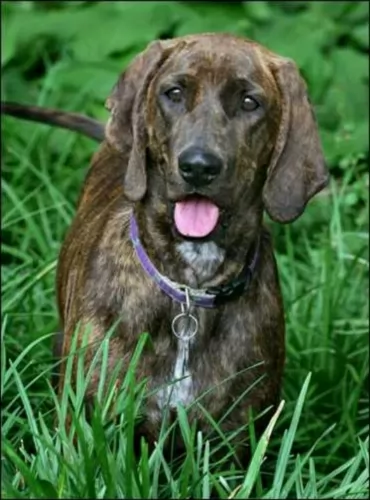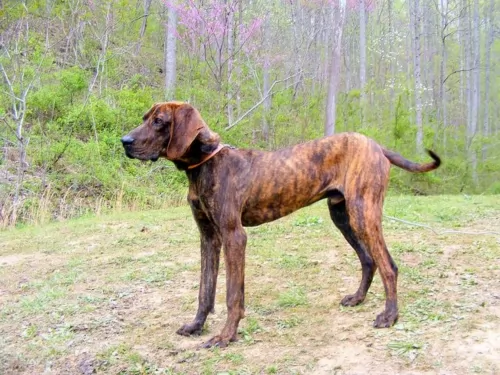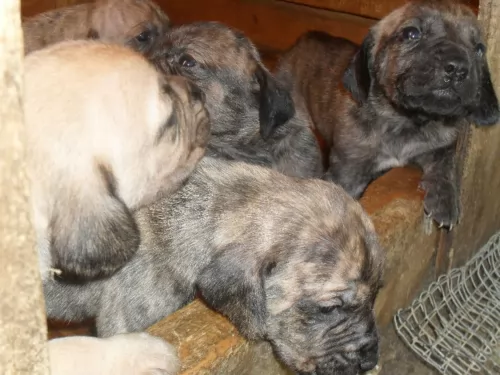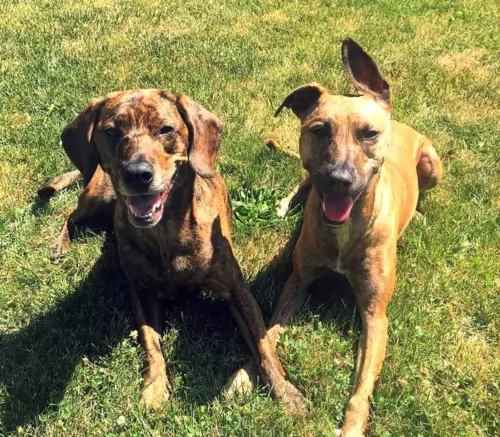 MyDogBreeds
MyDogBreeds Plott Hound is originated from Germany but Irish Wolfhound is originated from Ireland. Plott Hound may grow 15 cm / 5 inches shorter than Irish Wolfhound. Plott Hound may weigh 27 kg / 59 pounds lesser than Irish Wolfhound. Plott Hound may live 4 years more than Irish Wolfhound. Plott Hound may have more litter size than Irish Wolfhound. Plott Hound requires Low maintenance. But Irish Wolfhound requires Moderate maintenance
Plott Hound is originated from Germany but Irish Wolfhound is originated from Ireland. Plott Hound may grow 15 cm / 5 inches shorter than Irish Wolfhound. Plott Hound may weigh 27 kg / 59 pounds lesser than Irish Wolfhound. Plott Hound may live 4 years more than Irish Wolfhound. Plott Hound may have more litter size than Irish Wolfhound. Plott Hound requires Low maintenance. But Irish Wolfhound requires Moderate maintenance
 The Plott Hound is a scent hound who has always been used for for hunting bears. The dog may well be the state dog of North Carolina, but it isn’t well known.
The Plott Hound is a scent hound who has always been used for for hunting bears. The dog may well be the state dog of North Carolina, but it isn’t well known.
The Plott Hound is an old dog breed descending from several Hanoverian Schweisshunds which were brought to North Carolina way back in 1750. They were brought by a German immigrant, Johannes George Plott, and that is why it is believed that the dog hails from Germany.
It is believed that in the early 1900s the dog was mated with black-and-tan hounds, giving the canine additional scenting skills as well as its black-saddled brindle pattern. The dog breed has since been registered by the United Kennel Club and is also registered by the American Kennel Club.
 It is believed that the Irish Wolfhound is an ancient breed and that it was brought to Ireland as early as 7000 BC.
It is believed that the Irish Wolfhound is an ancient breed and that it was brought to Ireland as early as 7000 BC.
These dogs were bred as hunting dogs as well as guard dogs. There was a time when these huge canines were only allowed to be owned by the nobility. The breed died out somewhat, but Scotsman Captain George Augustus Graham made efforts to restore the breed’s numbers.
Captain Graham devoted his life to making sure the Irish Wolfhound’s numbers were built up, and the breeding program included Great Danes, Borzois, English Mastiffs and Scottish Deerhounds.
 The Plott Hound is a large dog standing between 50 and 71cm in height, both male and female, and weighing in at between 18 to 27kg.
The Plott Hound is a large dog standing between 50 and 71cm in height, both male and female, and weighing in at between 18 to 27kg.
The dog’s coat is available in a number of brindle shades such as red-, blue, tan-, brown and black brindle. The ears of the dog are long and floppy and the tail is also long and held up or down, depending on whether the dog is quiet or excited. He is active and would not be recommended for a small homes in the city.
Bold, alert and intelligent, the Plott Hound is a confident, courageous and loyal pet, being somewhat aloof around strangers.
Typical of any hounds, he is a strong willed, independent dog, and this is why he will need training and socialization. These make him obedient so that he can respond to simple commands such as sit, lie down, come and stay. This makes him a pleasure to have around wherever you go with him. He is also protective, making him an excellent watchdog.
 The tallest of the sighthounds, the Irish Wolfhound looks like a large Greyhound, only he has a rough, wiry type of coat.
The tallest of the sighthounds, the Irish Wolfhound looks like a large Greyhound, only he has a rough, wiry type of coat.
He is also gracefully built and known as a gentle giant. The double coat which can be fawn, red, white, grey, black or brindle is straight to wavy.
He stands at about 81 to 86cm and weighs roughly 48 to 54kg. This is one of the few dog breeds that you can’t really call social. He loves his own human family, and becomes unhappy and ‘down-in-the-dumps’ when separated from his family members for too long. He is a quiet dog who tends to be somewhat introverted and reserved, while being highly intelligent.
He will require being trained and socialized to make him obedient as he is an independent dog. He takes his role as family protector seriously and even though he is quiet, he is ready to take on anyone who threatens his property.
The Irish Wolfhound is a gentle, quiet, soft-natured, easy-going dog and even though it is such a large dog, it doesn’t throw it’s weight around but is calm and patient around the elderly and children in the home. It can tend to be aggressive with animals he isn’t familiar with.
He is an intelligent dog, but even so he may be quite resistant to training as he is strong-willed and determined to have his own way. These dogs need to be trained and socialized otherwise they just do their own thing.
 The Plott is a bold, aggressive type of dog, but he is also loving, loyal and intelligent.
The Plott is a bold, aggressive type of dog, but he is also loving, loyal and intelligent.
If you want him as a pet and companion, another bonus part is that his smooth, short coat makes him a low maintenance breed. He’s good looking too, and with training and socialization he’s going to make a great family friend, guardian and pet.
 The most notable aspect of the Irish Wolfhound is his amazing height. The legs are long, the body narrow. He is gentle and easy-going but because he is a sighthound he loves to give chase after animals.
The most notable aspect of the Irish Wolfhound is his amazing height. The legs are long, the body narrow. He is gentle and easy-going but because he is a sighthound he loves to give chase after animals.
He is capable of living in the city or countryside, but your home will need to cater to his size. He isn’t particularly energetic, enjoying a quiet life but he will absolutely need to be exercised.
Provide your gentle giant with everything needed to make him content, and you’ll have a faithful, loving friend for about 10 years.
 Your Plott Hound is a healthy dog breed and can live to be anything from 12 to 14 years of age. Just like with any other dog breed, they are prone to certain health conditions. It is however, highly unlikely that he will get any of the diseases, but it is good to be aware of some of them -
Your Plott Hound is a healthy dog breed and can live to be anything from 12 to 14 years of age. Just like with any other dog breed, they are prone to certain health conditions. It is however, highly unlikely that he will get any of the diseases, but it is good to be aware of some of them -
There are many forms of cancer and some of the symptoms of the disease include lumps, sores that won’t heal, difficulty with breathing, lack of energy and black stools. Cancer is of course life threatening and treatments will include the likes of chemotherapy, radiation and even surgery.
This is also a deadly disease where parasites infect a dog’s heart and arteries. With a mosquito bite, dogs are exposed to larvae, and if left unchecked, the larva can develop into large worms. Your dog will be coughing, be lethargic and in a run down state. This disease certainly requires veterinary intervention.
There are so many things that can cause your dog to vomit and also have diarrhea. Eating the wrong foods, having an infection such as parvo for instance can cause a dog to vomit. An isolated case of vomiting needn’t be cause for alarm, but if your dog is vomiting repeatedly, you’ll need to get him to the vet.
This is more common in small dogs, but big dogs can easily become obese too. Being overweight has a host of negative health effects on your dog such as opening up diseases such as diabetes and putting too much stress on the joints.
 One wonders why breeders seem so bent on breeding such large dogs when they have health issues and they don't live particularly long. Not only do they cost a fortune to feed, but large dogs like this are more prone to illnesses and won’t live as long as small dog breeds. This big dog can live up to 10 years of age or so.
One wonders why breeders seem so bent on breeding such large dogs when they have health issues and they don't live particularly long. Not only do they cost a fortune to feed, but large dogs like this are more prone to illnesses and won’t live as long as small dog breeds. This big dog can live up to 10 years of age or so.
For starters, just because he is a deep chested dog, bloat or gastric torsion can be a threat. Other illnesses to look out for are dilated cardiomyopathy and bone cancer.
This is a disease of the heart muscle where the enlarged heart won’t function properly. The upper- and lower chambers of the heart are enlarged and the heart isn’t able to pump blood out properly. When the heart’s ventricle doesn’t pump enough blood into the lungs, fluid accumulates in the lungs and this ultimately leads to congestive heart failure.
Older dogs battle more with this heart disease and it is also more common in some dog breeds of which the Irish Wolfhound is one. Your dog will have shortness of breath, coughing and abdominal distension. He will need to get to the vet for medical tests.
Bone cancer can strike any dog, but you’ll find in more commonly with larger dog breeds. It can spread quickly and the long term prognosis isn’t good. It’s not easy to pick the disease up and it can mean joint pain for your pet and even lameness.
Your dog will be tired too. Your vet will do X-rays and other tests, but unfortunately the prognosis isn’t usually good. Big-dog breeders should take this into consideration.
 The Plott is a hunting dog, used to being outside and used to being active and busy. For anyone who can satisfy his need to be busy, he’ll make a fantastic pet, companion and watchdog. Provide him with a variety of activities to keep him occupied – a walk, ball games, runs in the park, swimming and hikes.
The Plott is a hunting dog, used to being outside and used to being active and busy. For anyone who can satisfy his need to be busy, he’ll make a fantastic pet, companion and watchdog. Provide him with a variety of activities to keep him occupied – a walk, ball games, runs in the park, swimming and hikes.
Your Plott Hound has a short coat which sheds. He is regarded as a low maintenance dog and will require a brush twice a week. A rubber curry will keep the coat gleaming.
Check inside his ears for redness which can be indicative of an ear infection. Check his eyes too and make sure they are bright, clear and alert.
Trim your pet’s nails.
If you don’t intend to go in for breeding, have your dog neutered or spayed to avoid unwanted pups.
Provide your dog with a nice warm, dry place to sleep. When he goes outside, ensure he has both shade and sunshine to lie down in.
Make sure you feed your Plott Hound high quality food to promote longevity and good health. There are some commercially manufactured dog foods that have bad ingredients in them which can actually make your pet sick. Buy a quality food, and try to add in some homemade food too from time to time. You don’t have to make feeding your dog a complicated affair – some chopped up boiled chicken, brown rice or pasta and some vegetables such as sweet potato, carrots and spinach will keep your pet healthy and happy. You can add it into his kibble once in a while for a treat and also give him a little bit of raw meat occasionally. Easy, simple and nutritious – just like your pet wants. He doesn’t want you popping chocolate, raisins, peanuts, coffee and spicy foods into his mouth or bowl as it upsets his stomach.
Make sure he always has access to fresh, cool water.
 This isn’t a particularly energetic dog and he can tend to become lazy. Don’t allow this as becoming unfit and overweight can be very bad for such large dog. Being so large already puts stress on the dog’s body, and the dog is already susceptible to cardiac and skeletal problems. Allowing him to become lazy and overweight will be a death sentence for this large dog. It is imperative to make sure you take him on walks and play games with him.
This isn’t a particularly energetic dog and he can tend to become lazy. Don’t allow this as becoming unfit and overweight can be very bad for such large dog. Being so large already puts stress on the dog’s body, and the dog is already susceptible to cardiac and skeletal problems. Allowing him to become lazy and overweight will be a death sentence for this large dog. It is imperative to make sure you take him on walks and play games with him.
The coat of your dog is thick and medium length and he will require being brushed at least twice a week. You may want to also trim the longer hair you find around his face and legs.
When it comes to his ears, you can moisten some cotton wool and wipe the inside of his ears to remove dirt and excess wax. Remember not to probe too deeply to avoid damaging the ear. If you’re uncertain how to do this, your vet can explain to you how its done.
Check his teeth regularly as dental disease can affect other areas of the body too. Don’t allow his nails to get too long as they can cause paw problems and the nails can hook onto things and cause injury.
Because this is a giant breed, the puppy will grow for a long time. Speak to your vet about how to ensure you feed your puppy in such a way that he doesn’t grow too quickly.
If you feed your dog a commercially manufactured food, make sure its one of the top quality brands. Include home-made cooked food such as chicken, rice and vegetables into his kibble from time to time, and also try to feed him some raw meat occasionally.
Fresh, cool water must be available to your Irish Wolfhound around the clock.